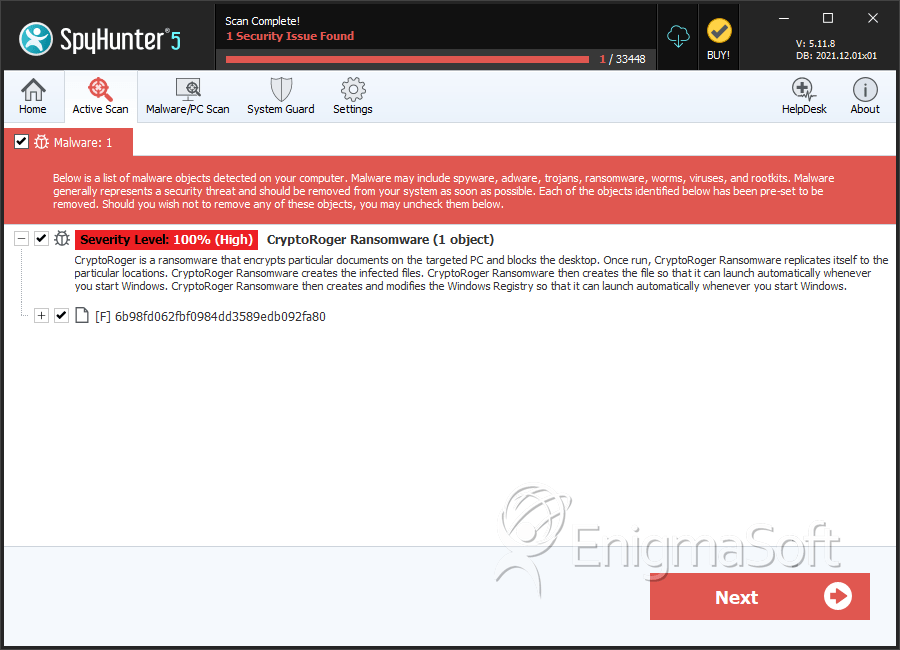CryptoRoger Ransomware
The CryptoRoger Ransomware is a ransomware Trojan that can be recognized easily because it uses the extension '.CRPTRGR' to identify the files that have been encrypted. Like most ransomware encryption Trojans, the CryptoRoger Ransomware is designed to encrypt the victim's files using an advanced encryption algorithm. Files that have been encrypted by the CryptoRoger Ransomware become inaccessible. The computer user is forced to pay a large ransom to regain access to the files. Essentially, the CryptoRoger Ransomware takes the victim's computer hostage in exchange for a ransom.
Table of Contents
The CryptoRoger Ransomware may Enter a Computer Through Spam Email Messages
The CryptoRoger Ransomware was first spotted in 2016. The CryptoRoger Ransomware uses the AES encryption to encrypt the victim's files. Currently, the CryptoRoger Ransomware demands a ransom amount of 0.5 BitCoin, approximately $360 USD at the current exchange rate. Unfortunately, once the CryptoRoger Ransomware has encrypted the files, they cannot be decrypted without the decryption key. PC security analysts have not determined how the CryptoRoger Ransomware is being distributed currently. However, it is likely that the culprits are spam email messages. The CryptoRoger Ransomware can be included in these messages in the form of a corrupted file attachment, or through an embedded link that leads the victim to an attack website that installs the CryptoRoger Ransomware on their computers.
How he CryptoRoger Ransomware Attack ss Carried Out
As soon as the CryptoRoger Ransomware is installed, it scans all drives connected to the affected computer, searching for data files that match a list of file extensions in the CryptoRoger Ransomware's configuration settings. The following are examples of the files that the CryptoRoger Ransomware and similar threats encrypt in their attack:
.3gp .apk .asm .avi .bmp .cdr .cer .chm .ckp .conf .cpp .css .csv .dacpac .dat .db3 .dbf .dbx .dcx .djvu .doc .docm .docx .epub .fb2 .flv .gif .ibooks .iso .java .jpeg .jpg .key .md2 .mdb .mdf .mht .mhtm .mkv .mobi .mov .mp3 .mp4 .mpeg .mpg .mrg .pdf .php .pict .pkg .png .pps .ppsx .ppt .pptx .psd .rar .rbw .rtf .sav .scr .sql .sqlite .sqlite3 .sqlitedb .swf .tbl .tif .tiff .torrent .txt .vsd .wmv .xls .xlsx .xml .xps .zip.
After encrypting a file and changing its extension, the CryptoRoger Ransomware will deliver a ransom note. The CryptoRoger Ransomware's ransom note is contained in an HTML file named '! Where_are_my_files!.html,' which contains instructions on how to pay the CryptoRoger Ransomware ransom. According to this ransom note, computer users must install Tox, an anonymous messaging platform, and then contact the CryptoRoger Ransomware's creators at the following Tox address:
F12CCE864152DA1421CE717710EC61A8BE2EC74A712051447BAD56D1A473194BE7FF86942D3E.
According to the CryptoRoger Ransomware's ransom note, computer users must send the 'keys.dat' file to the CryptoRoger Ransomware's creator to decrypt the files. It is likely that this file contains the AES key that was used during encryption. This key is itself encrypted using the RSA encryption. The con artists can use their own master private RSA key to decrypt this key and send it back to the victim in exchange for the ransom payment. This is a somewhat primitive way of doing things since other types of attackers that have similar strategies will relay the key themselves when communicating with their Command and Control server. As a final part of the attack, the CryptoRoger Ransomware creates a .VBS file in the Windows Startup folder. This allows the CryptoRoger Ransomware to run every time Windows starts up automatically. This means that the CryptoRoger Ransomware will continue to encrypt files on the victim's computer until it is completely removed with the help of a reliable anti-malware program that is fully up-to-date.
Dealing with the CryptoRoger Ransomware
The best way to deal with the CryptoRoger Ransomware is by taking preventive measures. PC security researchers recommend that computer users use a reliable backup method to keep a copy all of their files. This will make computer users completely invulnerable to the CryptoRoger Ransomware and similar attacks, since instead of having to pay the ransom they can simply remove the CryptoRoger Ransomware and reinstall their files directly from the backup.
SpyHunter Detects & Remove CryptoRoger Ransomware

File System Details
| # | File Name | MD5 |
Detections
Detections: The number of confirmed and suspected cases of a particular threat detected on
infected computers as reported by SpyHunter.
|
|---|---|---|---|
| 1. | 6b98fd062fbf0984dd3589edb092fa80 | 6b98fd062fbf0984dd3589edb092fa80 | 0 |


Submit Comment
Please DO NOT use this comment system for support or billing questions. For SpyHunter technical support requests, please contact our technical support team directly by opening a customer support ticket via your SpyHunter. For billing issues, please refer to our "Billing Questions or Problems?" page. For general inquiries (complaints, legal, press, marketing, copyright), visit our "Inquiries and Feedback" page.